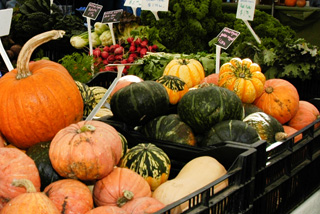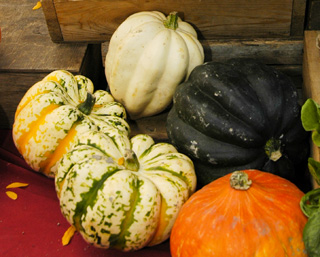Winter Squash : Later is Greater
It’s the second week in December when holiday music fills the airwaves, kids dance through Christmas tree lots pointing to “this one, no that one”, and our slightly scratched, forever treasured decorations come out of the closet once again. Wait a second. Are those autumn squashes still sitting on the front porch? If so, you might want to read on before you run out there and pitch them.

Photo by Noreen R. Frink
Those good old winter squashes that come in all sizes, shapes and colors are much more than festive tributes to Halloween and Thanksgiving. They are loaded with valuable nutrients, and get ready, they can taste absolutely wonderful if you can get brown sugar, nutmeg, maple syrup and marshmallows out of your mind.
From October through December at farmers markets everywhere, winter squashes steal the show flaunting their raucous colors, gnarled skins and nature defying shapes. Shoppers just can’t get enough of them.
One Saturday morning at Seattle’s University Farmers Market, I noticed a stall that had eight different squashes on display, each with a tasting bowl offering cooked, bite size morsels. Except for the butternut and the small orange pumpkin, every squash was new to me. Dumbfounded by the variety of flavors, I decided to get to know winter squash.
Here is some of what I learned and a few recipes to try in late January when you are ready for simple healthful food…and winter squashes are ready eat.
- Winter squashes have either thin or thick skin. You can tell the difference by looking at the skin to determine whether or not it can be removed with a vegetable peeler. If you think it can, the squash probably is thin-skinned. Examples include Butternut, Acorn and Delicata. Gourds also are winter squashes but their flesh is too thin to develop any flavor.
- After a winter squash is cut from the vine, it should be stored in a dark, cool place (40º to 55º F) for from 2 weeks (thin-skinned) to 16 weeks (thick-skinned). During that time it quietly converts starches to sugar, getting sweeter and more flavorful with each day. Eventually the enzymes that convert the carbohydrates to sugar are spent, and the squashes slowly dry up.
- The healthful part of winter squash is pretty impressive. They are filled with complex carbohydrates (sugar and starch) and fiber that together significantly benefit digestion, and they also contain potassium, niacin and beta-carotene (which the body converts to Vitamin A).
Conversely, if the squash’s skin looks tough or ruddy and impossible to peel with a vegetable peeler it probably is thick-skinned. Those include Ambercup, Autumn Cup, Buttercup, Hubbard, Carnival, Musquee de Provence, Turban and Kabocha.
Click here for photos of different winter squashes. The difference between the thin and thick-skinned squashes is pretty obvious in the photos.
Winter squash should not be stored in a refrigerator for more than a couple of days as humidity causes them to rot.
All winter squashes can be stored for about two weeks at room temperature, and they will sweeten slightly. Actually that describes most squash we eat during our lives. Go to the store, usually before Thanksgiving, buy a squash, cook it in a week or so, find it bland and boring, add lots of salt or brown sugar or sausage or anything else that has flavor and forget squash for another year.

Photo by Noreen R. Frink
Click here for a summary of Nutrition Facts for 1 cup of steamed winter squash.
Notice the meager 39 calories! How many foods can you name that contain that many nutrients, virtually no fat and less than 40 calories?
By mid-December, most winter squashes have been off their vines for at least a month, more likely two or three. So, if you don’t have any from your garden to store, I recommend purchasing them from local farms, from farmers markets or grocery stores that sell local organic produce. Don’t be afraid to ask your grocer or produce manager where the winter squashes were grown, when they came into the store, and how long they have been out on display. Remember, if they have been at room temperature for a week, the sugars are almost spent and the internal moisture is depleted. Terrible? No, but certainly not as moist and flavorful as they could be.
Finally, any thick-skinned winter squash that was picked in October and stored properly will not be ready to eat until late January. By then those rich holiday dinners will be a faint memory and you will be ready for straightforward foods.
So here’s a plan. About a month from now, pull a squash from that cool, dark storage place you found and leave it out on your kitchen counter for 2 or 3 days to force its final bit of sugaring. I’ve included a recipe in this post and will be adding three more delicious winter squash recipes as my next three posts. Stay tuned, and get ready to become a winter squash aficionado (or maybe just a fan).